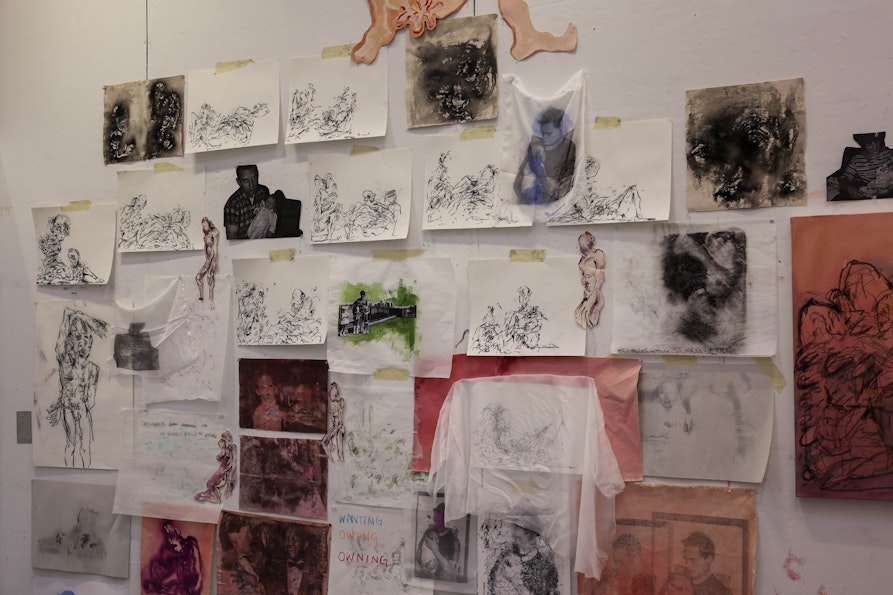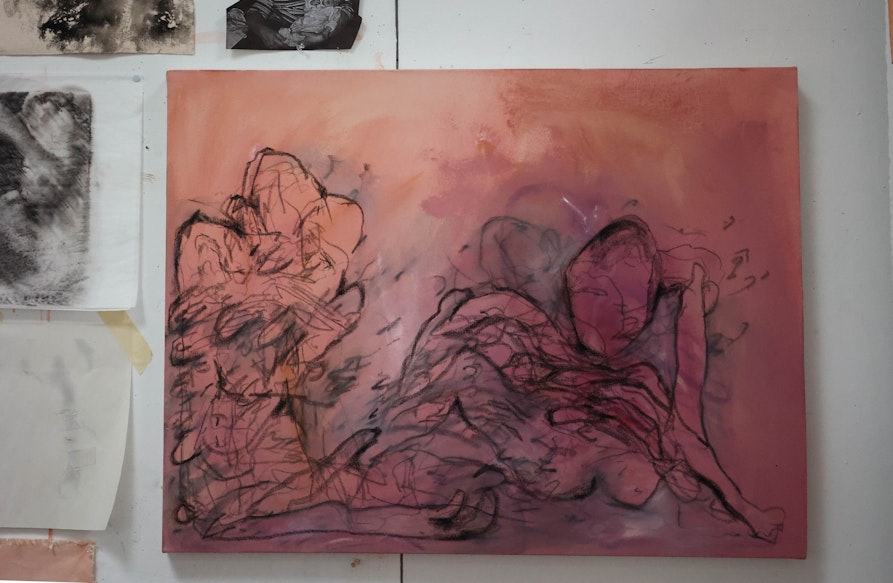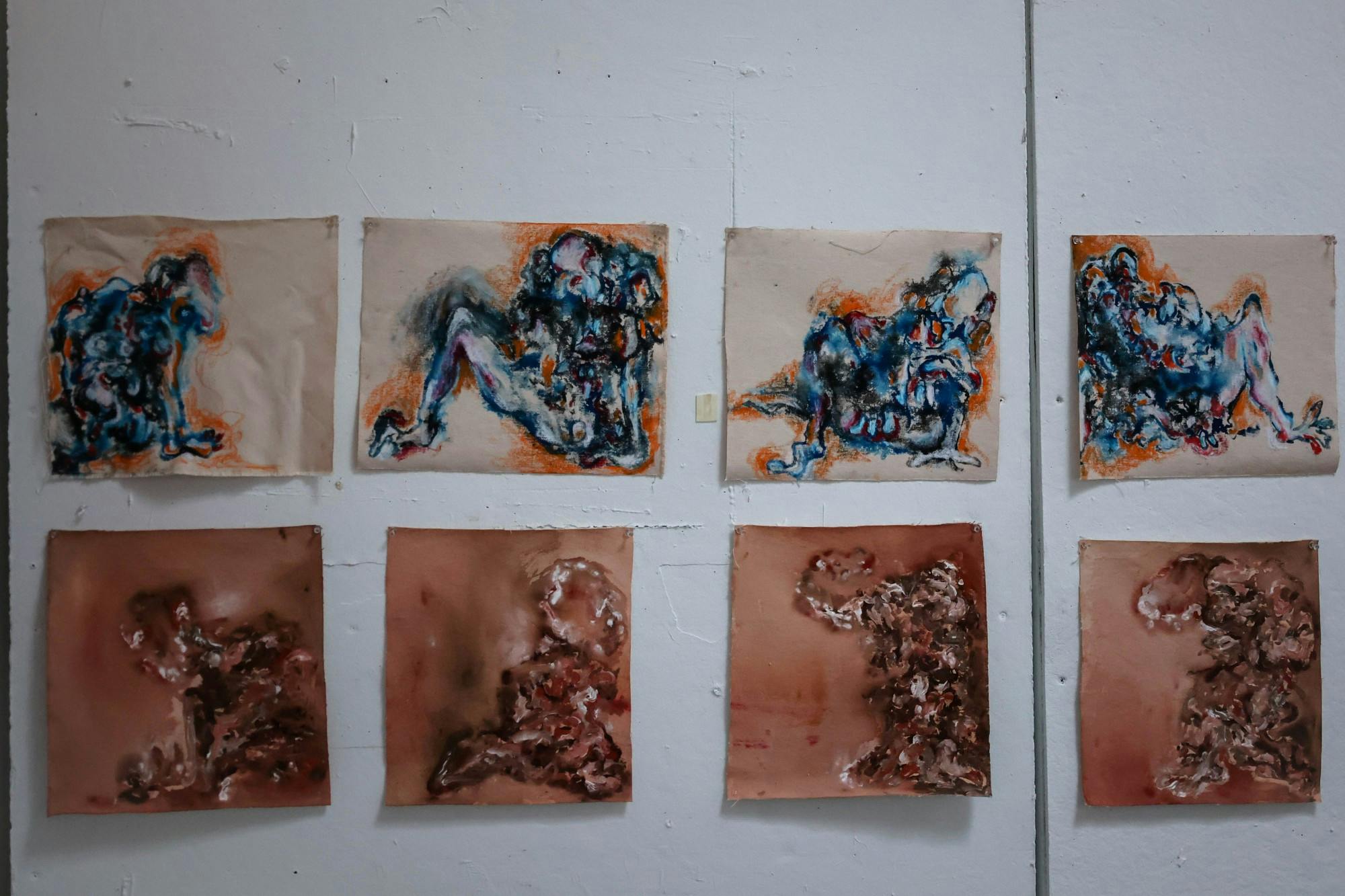Studio art intern Phoebe Kong ’21 sits at the desk of her studio in the Black Family Visual Arts Center. As one of five chosen interns, she will spend the year building her portfolio and assisting in undergraduate art classes before applying to MFA programs. Behind her is a collage wall composed of various prints of her family, each connected by her various drawing studies.
The wall is an ode to her family members — ones she knows well and the ones she will never be able to meet. It’s an attempt to explore her heritage, connecting the pieces and people of her family and filling in the missing gaps with her own art, according to Phoebe.
“So much of what we think and what we believe about our families is romanticized,” Kong said. “The further away you get from your relatives, you hear all these almost epic-like stories about what an amazing person they were and what they did. I realized I’ll never really get to know any of [my relatives who have passed away]… These relationships that I’m studying are not made up, but I’m filling in [the gaps] on my own.”
For Kong, the complexity of human relationships — relationships with oneself and with others — has always been a source of inspiration. Much of her art, she said, seeks to explore human tension: connection and disconnection, desire and rejection, satisfaction and frustration.

Kong's sketch wall.
“There’s almost this universal experience of loving people and also having issues with them, or wanting to connect with somebody, but struggling to do so,” Kong said. “And wanting to receive love and not getting it …. I’m trying to take … the tensions that we experience as a part of being human and put them in obvious terms.”
To convey these emotions, informed by her own feelings of anxiety and personal relationships, Kong uses contrasting colors and intertwined figures.
“There’s a visual tension [in my art], and you can see that with a lot of my mark making. With a lot of the bright colors that I use, there’s a tension there,” Kong said. “But the figures that I draw, they also can’t get away from each other. They're always kind of connected through line or paint … It’s a literal connection to allude to a more abstract idea of what we feel with people in our lives.”
Gerald Auten, senior lecturer and director of exhibitions for the studio art department, views Kong’s art as deeply personal and impactful, noting the impressive development of her unique drawing and painting style.
“She early on developed a very personal style — it’s almost like she’s drawing with paint… [Her art is] sincere,” Auten said. “I think she’s found her own kind of language.”
Auten, who is colorblind, specifically points to Kong’s use of color and value as to what makes her work stand out.
“There’s something about the color and how she uses value that I really respond to,” Auten said. “I think colorblind people tend to look at work through value, and in terms of that, she’s really got that going — it’s really excellent.”
Studio art professor Enrico Riley, a critic of Kong’s senior thesis, highlights the interconnectedness of Kong’s art — in relation to both herself and the audience — as being impressive.
“She is a very gestural and kinetic artist,” Riley said. “I think there’s a real sense of energy in her painting. There’s also a sense of interiority, a very personal conversation she’s having with herself.”

“Chorus of Both (A Reluctant Oath)” by Kong.
Kong’s friend and former sculpture art teaching assistant Lucy Li ’19, who was also a studio art intern at Dartmouth, echoes both these perspectives.
“What is cool about her painting is that you don’t really know what's going on, but at the same time you feel like you have this window into a very chaotic, but also beautiful, but also strange world,” Li said. “It feels like you’re being let in on a little secret of what’s going on internally.”
This medley presented in Kong’s art, though, is not to comfort the viewer, she says. Rather, it is intentionally unsettling, and prompts the viewer to take time for personal reflection.
“My goal is never really to please the viewer or to calm the viewer,” Kong said. “If anything, it’s to evoke some kind of discomfort or maybe confusion and irritation as to what's going on…I want there to be some kind of urgency, some kind of sense of anger…I want the audience to feel how I felt when I paint[ed] it.”
In March 2022, Kong will display her work in the Hop rotunda. Additionally, this summer, as one of two recipients of the 2021 Perspectives on Design award, Kong will have an exhibit showcase at the Jaffe-Friede Gallery in the Hop. She will collaborate with fellow POD award recipient Carson Levine ’21 GR’22, who is experimenting with digitally-controlled lighting to alter how viewers see art consisting of objects and paint, according to Levine.
As Kong reflects back on her time as an undergraduate art student, she has some advice for other student artists and aspiring creatives.
“A while ago, I heard somebody say ‘you can’t be good at anything unless you’re really bad at it,’” Kong said. “For a really long time, and still now, I would get mad at myself for making bad art….Don’t be afraid of making bad art.”
Lucy Li is a former opinion editor of The Dartmouth.
Correction appended (6:00 p.m., Jan. 16, 2022): A former version of this article incorrectly described Kong’s collaboration with Levine and also omitted Levine’s graduate student class year. The article has been updated.




